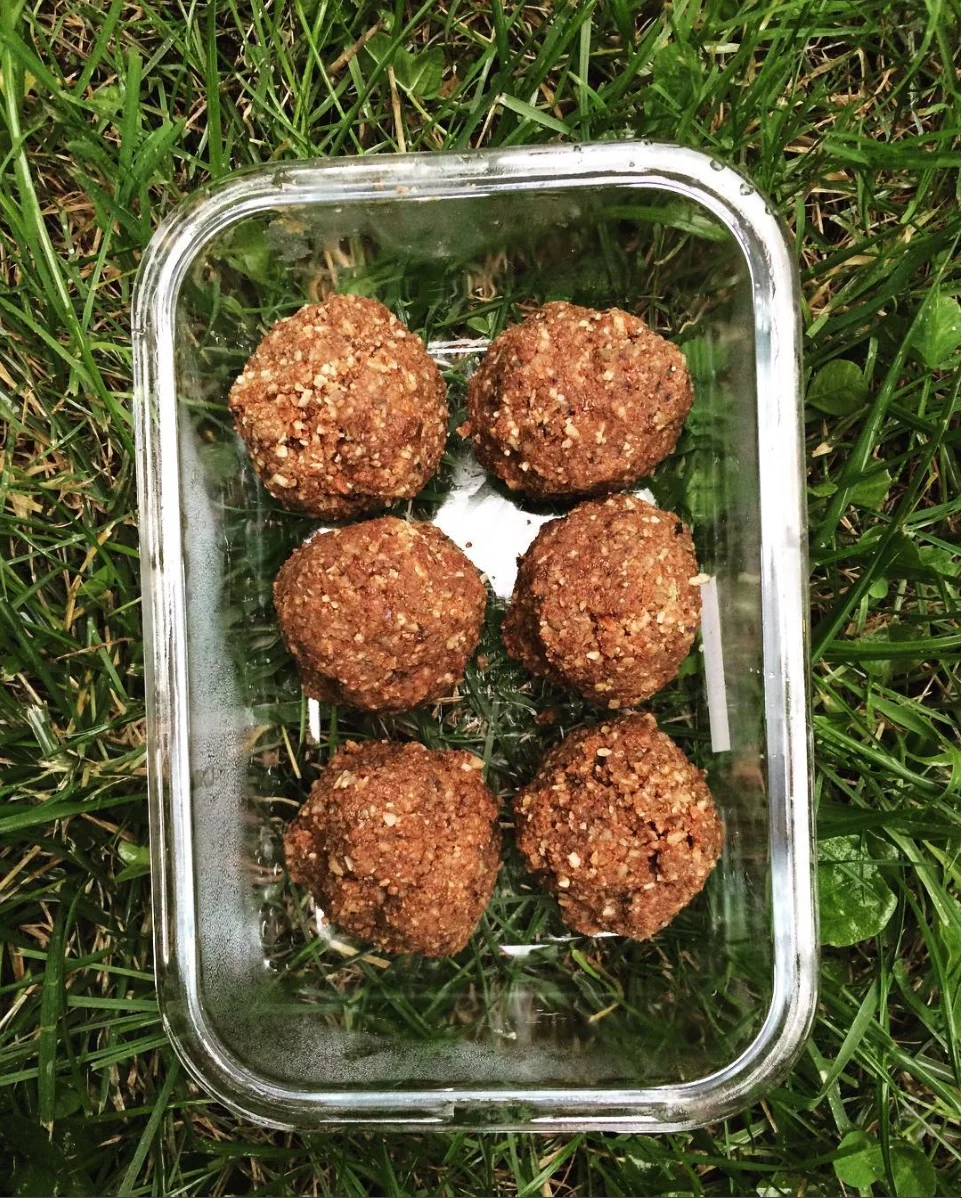Energy Balls
This is another recipe that I have made many iterations of, and finally perfected it just to my taste. It is basically like a Lara bar but even healthier and more delicious (if I do say so myself). It is a little bit chocolatey, a little bit salty, and not too sweet. I've increased the nutritional density with the added greens powder and sea vegetable flakes (you should be able to get these from any health food store), and upped the protein by adding protein powder. This is my favourite quick and easy go-to snack for work, school, or the middle of a busy afternoon.
Recipe:
1/2 c. shredded or flaked coconut, unsweetened
1c. toasted pumpkin seeds
1/2 c. almond meal/flour or 1 c. raw almonds
7 dates, soaked in hot water to soften
1/3c. protein powder of your choice
1 Tbsp. spinach powder or other greens powder
1 Tbsp. of sea vegetable flakes
1 tsp. vanilla extract
3 Tbsp. cacao powder
a large pinch of sea salt
Boil water. Put dates in a bowl and cover with hot water, leaving for a few minutes to rehydrate and soften. Add pumpkin seeds, coconut and almonds (if whole) to blender and blend to a medium-fine grain. Don't let it go too far or it will become nut butter. Remove the dates from the water, reserving the remaining hot water aside. Add the dates and blend, then add the rest of the ingredients and blend until well mixed. Slowly add the water until mixture is firm enough to hold together if you squeeze it in the palm of your hand. Form into balls and place on a wax paper lined sheet in the fridge to harden. Or even easier - press into a rectangular loaf pan (also lined with wax paper), and put in the fridge to harden, then slice into bars. Store in a closed container. Will last about 7-10 days in the fridge, or keep in the freezer and snack on as needed! Recipe makes about 10 pieces, depending on how large you like your balls...
I continue to play with this recipe because it is fun to have variation in your snacks. I've tried a peanut butter version, a tahini version, and a mint version (with mint extract). I've coated the top with melted chocolate. I have used plain whey protein, chocolate orange flavoured brown rice protein with stevia, and vanilla flavoured protein. I also like to use walnuts instead of pumpkin seeds sometimes. Add more dates if want it sweeter. If you use chlorella or spirulina as your greens powder, reduce the quantity because these have a much stronger flavour. There is lots of room to experiment - the key thing is to get the texture right so you can shape the mixture into balls that will hold together. Try making my basic version first and then modify it to suit your taste. Have fun and enjoy!
Health Benefits: What do I mean by nutritional density? I am referring to foods that have a high proportion of vitamins, minerals, and phytochemicals relative to the amount of calories (carbohydrate, protein, or fat) consumed. Quite simply this recipe is homemade from whole foods and does not contain any fillers or other weird ingredients, so will be nutrient dense. But to get more specific...
Pumpkin seeds contain healthy monounsaturated fats, amino acids tryptophan and glutamate, B vitamins, and minerals including magnesium, manganese, zinc, and iron. Almonds also contain monounsaturated fats, B vitamins (especially biotin), protein, and minerals such as manganese, copper, potassium, phosphorus, calcium, among other things. Both contain antioxidants in the form of flavonoids and vitamin E, which help mitigate free-radical damage (cellular damage that results from sun, pollution, cigarette smoke, ect).
People often think of coconut as high in saturated fats and therefore bad for you. However coconut oil is high in medium-chain triglycerides (MCTs), which are metabolized in your body differently than most fats. Extra detailed explanation for the nutrition nerds: most fats require bile to emulsify them in your GI tract so they can be absorbed into your lymphatic system, and from there transported into your bloodstream where they are distributed to the liver or deposited in adipose tissue. MCTs are small enough to be directly absorbed by your intestinal cells, so instead enter the portal circulation which is filtered by the liver before going to the rest of your body. In the liver they are rapidly absorbed by your mitochondria (which produce ATP, the energy storage molecule for your body) because they don't require the enzyme carnitine to be transported across the mitochondrial membrane. Thus they are more rapidly utilized as a source of energy, producing ketone bodies. This can be helpful for those on a ketogenic diet, which a person may choose to do for various therapeutic reasons or for weight loss. MCTs have been shown to prevent the fat depositions that characterize atherosclerosis and lead to metabolic syndrome and cardiovascular disease. In addition, your brain primarily uses glucose for energy, but will also use ketone bodies (which is important because other fats cannot cross the blood-brain barrier). In fact, coconut oil has been shown to improve cognitive function in Alzheimers disease. Essentially, coconut is a good source of energy in the form of healthy fats, supports healthy brain function, plus also contains fibre, potassium, and more B vitamins.
Seaweeds are a really nutrient dense food that are high in many vitamins and minerals (consider that they grow in sea water!) as well as omega-3s. Your greens powder will probably say all over the packaging why it is good for you. Cacao powder is distinct from cocoa powder in that it is un-roasted and less processed than cocoa, and is said to contain more enzymes, vitamins, and antioxidants as a result. I haven't found a clear source to back this up, but cacao is still my preference though I tend use both depending on what I have (particularly because cacao is much more expensive). Mmm chocolate is good for the brain.
All these things together, good quality fats, proteins, and just enough sugar, results in a snack that will fuel your body and brain while also keeping your blood sugar balanced. The nutrient, mineral, and phytochemical content provide cofactors for the many reactions in your cells, supporting essential functions throughout your whole body. And perhaps most importantly, eating well can be a act of love for yourself and your body, and choosing to nourish yourself consciously has a powerful effect that goes beyond the biochemistry of nutrition.
Sources: I find the charts at Nutrition Data helpful to understand the nutritional makeup of specific foods, and also referred to this website for specific information about pumpkin seeds and almonds. I also sourced information from Dr. Karina Wickland, ND, so thank you to her!
Disclaimer: Information can be empowering, but we all have unique health profiles and needs. Health-related information contained in this post is intended to be general in nature and should not be used as a substitute for a visit with a Naturopathic Doctor. The advice is intended to offer only a general basis for individuals to discuss their medical condition with their health care provider. Always consult your licensed Naturopathic Physician, or visit the Boucher Naturopathic Medical Clinic for individual care.

